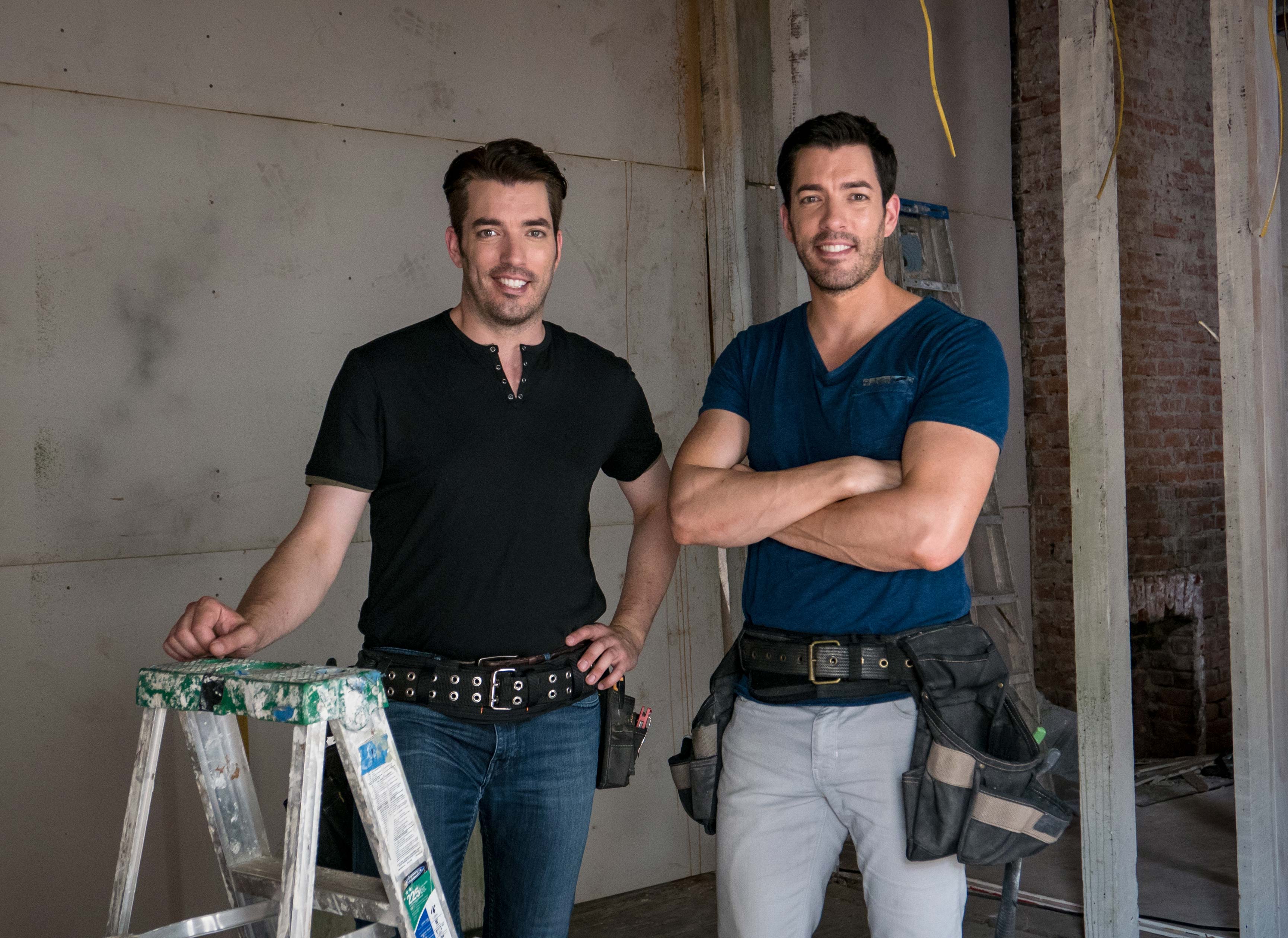His weakness is his back hair,” Drew Scott says without flinching.
The usually serious half of the popular HGTV twin host duo isn’t afraid to throw some jabs now and then.
“Drew is a robot!” his older-by-4-minutes twin retorts, referencing Drew’s workaholic tendencies.
The brothers are in Texas filming the latest episodes of Brother vs. Brother, one of their four home renovation shows that, in the past six years, have garnered them a dedicated audience of more than 18 million viewers.
Yes, the duo, both standing 6 feet 5 inches, could aptly be called tall, dark and handsome (they receive hundreds of marriage proposals each week on social media), but their true appeal lies in down-to-earth humor and playful sibling rivalry.
“We love using humor as a way to defuse any tension,” Jonathan says. “We take the job seriously but not ourselves.”
It seems to be working. Since launching their first show, Property Brothers, in 2011, they consistently rank among the top-rated programs on the HGTV network and continue to expand their offerings—the latest being Brothers Take New Orleans.
Related: The Property Brothers Share 4 Fixer-Upper Tips for Aspiring Entrepreneurs
Their big smiles and boyish on-air pranks bring a wave of nostalgia to anyone who has a sibling. But behind the playful banter are brothers who spent the last 30-something years building a multimillion-dollar digital and multimedia production brand from the ground up.
It began when they launched their first business at age 7: making and selling nylon-wrapped clothes hangers. While the rest of their neighborhood friends were busy kicking soccer balls and playing in the mud, the twins were designing business cards on construction paper with crayons. The name of the business: JAM Enterprises, which stands for Jonathan, Andrew, Mom Enterprises.
“Our slogan was ‘We take care of your hang-ups,’ ” Jonathan says with a laugh. “We were always a little entrepreneurial.”
With a little paid help from their mom, Joanne, older brother, J.D., and friends, the young business partners managed every aspect of JAM, from manufacturing and door-to-door marketing, to plans for growth. A neighboring woman owned a chain of Americana shops in Japan, and she ordered thousands of hangers that summer. Later they took on real estate, flipping their first house at 18. Now they have a furniture line, a New York Times best-selling home design book, four popular renovation shows and a multimedia strategy and production company, Scott Brothers Entertainment.
Avoid conflict by laying out each person’s specific roles in the business, both at its inception and as the brand continues to grow and expand.
Although Drew and Jonathan have worked together most of their lives, things didn’t always function as well as they do now. Working alongside family members adds complex layers that many new businesses can’t withstand. The brothers had to navigate how they interact with each other: who would handle which parts of the business and how they would resolve conflicts as business partners first and brothers second.

COURTESY OF HGTV
“People who say they can’t work with family—that’s just not how we work,” Drew says. “For us, we have a no-B.S. policy.”
Siblings should make the best business partners. And twins often know each other better than they know themselves. The majority of sibling research focuses on the relationship in the developmental stages. After all, the relationships we form with our siblings allow us a (mostly) consequence-free sandbox to test our social skills as they develop. We learn how to deal with conflict. We maneuver, deciding when to compete and when to back down. As Laurie Kramer, professor of applied family studies at the University of Illinois, says, siblings are the true agents of socialization and the ultimate shapers of our futures. And a 2009 study by Jill Suitor, a professor of sociology at Purdue University, found that the majority of adult siblings harbored good feelings toward one another.
Related: All in the Family
So why don’t more siblings sign up as business partners? Because, Jonathan speculates, we expect more from our family members than we would from a friend or colleague. And we often don’t communicate that expectation, which leads to feelings of resentment that can quickly implode a budding startup.
The veteran sibling businessmen offer this advice to anyone considering mixing business and family.
1. Identify your strengths and weaknesses.
Drew is charismatic and knows how to work a room, Jonathan says. “He has no problem immediately going over and introducing himself to whomever…. It’s a very excellent thing in business to be able to create those relationships and move forward.”
Jonathan likes to keep his head down and get to work. As a licensed contractor, he’s the one who typically handles the dirty work while Drew manages more of the brass-tacks side of the business.
Sit down with your sibling during the early stages of planning. List your strengths and weaknesses and ask your sibling to assess you. He or she might be able to offer valuable insight and a different perspective.
2. Know (and voice) your expectations.
We have high standards for our family members. We inherently know which sibling to go to when we’re feeling down and which one to rely on when we’re struggling to figure out a particularly difficult problem. But, as Drew and Jonathan warn, don’t expect too much when it comes to business. Just because your sibling might be great at creating a personal financial budget doesn’t mean they want to handle the books for the business.
Avoid conflict by laying out each person’s specific roles in the business, both at its inception and as the brand continues to grow and expand. “Regardless of how much you love each other,” Jonathan says, “treat it like a business.”

COURTESY OF HGTV
3. Divide and conquer.
Jonathan designs and renovates more than 50 houses a year for Property Brothers and Buying and Selling, while Drew manages the face of the brand. It’s a strategy which aligns with their individual strengths. But it requires trust and sometimes compromise.
If Drew disagrees on a particular design Jonathan chooses, for example, he can (and should) voice that opinion. But at the end of the day, Jonathan’s strength is design, and Drew says he had to learn to trust his brother’s instinct.
Healthy relationships are built on trust, communication and respect. These elements are vital all of the time, but especially when you’re on separate pages and making business-related decisions. Remember each other’s strengths and who should have the final say.
If your sibling disagrees with a decision you made in one of your strength areas, listen, consider their advice, but respectively remind them that you’re the lead. Explain the reasoning behind your decision because your sibling might just need to consider the problem from your perspective.
4. Align your goals.
Drew and Jonathan have a 10-year plan. They each listed their personal vision for the growth of their brand, and then sat down to see how those individual visions came together as a cohesive goal. Understand there might be some give-and-take. You might need to compromise a lesser want to capitalize on a more realistic goal.
“Drew and I are always looking at our situation, taking some calculated risks,” Jonathan says. “You have to constantly adapt.”
5. Establish a no-B.S. policy.
Sibling rivalry is inevitable, especially between two naturally strong-willed and competitive people such as Drew and Jonathan.
“If we have an issue, we get it out and we deal with it,” Drew says. “Being stubborn is not an asset. You have to be able to see things through other people’s eyes…. That’s going to help you grow.”
When you’re trying to resolve a conflict with your sibling, Jonathan advises, remember that there is never just one solution to a problem. Look at what you’re trying to achieve as a brand and as a team, and choose the solution that works best with those goals in mind.
6. Leave your personal feelings at home.
Drew and Jonathan shoot more than 60 hourlong episodes per year. Combine that with managing a growing furniture line, a book deal, a multimedia production company and a thriving social media presence, and the brothers spend a lot of time together.
“We get along so well,” Jonathan says. “I guess that’s the perk of having an identical twin. But we definitely have clear and concise communication about what the business is and what it isn’t.”
7. Don’t let success go to your head.
Part of Drew and Jonathan’s 10-year plan is to grow to a half of a billion-dollar business by the end of 2018.
“It’s been a great year for us,” Jonathan says. “Some people will say to us, ‘Wow, you guys are like this overnight success,’ which we laugh at because we’re like the longest overnight success ever.”
“Being stubborn is not an asset. You have to be able to see things through other people’s eyes…. That’s going to help you grow.”
No matter how large or quickly your organization grows, remember why you launched it in the first place. One episode of Brothers Take New Orleans chronicles a woman who was duped by a contractor after Hurricane Katrina destroyed her shotgun-style home. Broke and displaced, she’s been living in a tiny apartment with the most basic furniture for the past 11 years—until the brothers heard her story. They teamed up with a local disaster relief organization to overhaul the home and give it back to the original homeowner. For them, that’s the definition of succeeding.
“We’re inspiring families. We’re changing their lives in a positive way,” Drew says. “The bigger our brand grows, the better we’re able to help more people.”
Related: True Success Begins the Second You Start Giving Back
This article originally appeared in the March 2017 issue of SUCCESS magazine.









